MARIANI’S
Virtual
Gourmet
OCTOBER 13,
2019
NEWSLETTER
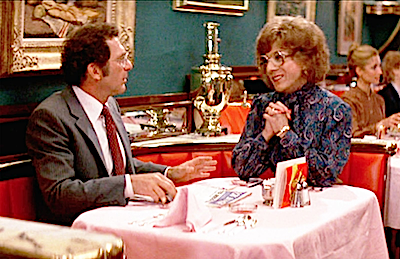
❖❖❖
IN THIS ISSUE
COGNAC, FRANCE
By John Mariani
NEW YORK CORNER
PHILIPPE CHOW DOWNTOWN
By John Mariani
NOTES FROM THE WINE CELLAR
CAMUS COGNAC SEES A
FUTURE IN DIVERSITY
By John Mariani
❖❖❖
COGNAC, FRANCE,
Worth a Detour
By John Mariani
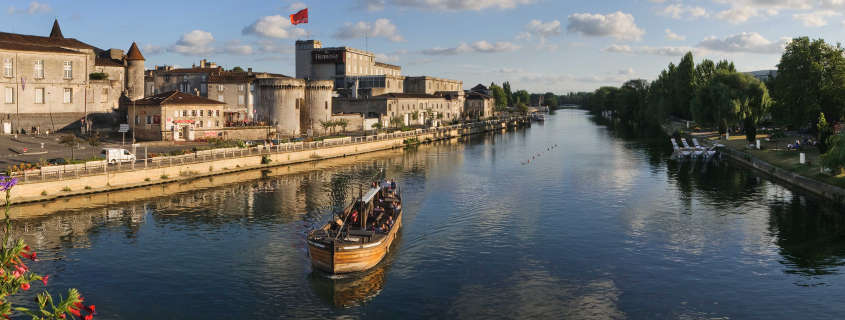
Cognac is a
sleepy river town of 20,000 people in the
Charentes department of France, whose principal
reason to visit, if one is on tour in the
region, is the illustrious brandy made there.
Were you to head south from Paris, 250 miles
away, visiting Orleans along the route, stopping
at Cognac is both requisite and a good place to
use as a base to visit Bordeaux, less than two
hours south, and La Rochelle, ninety minutes
east.
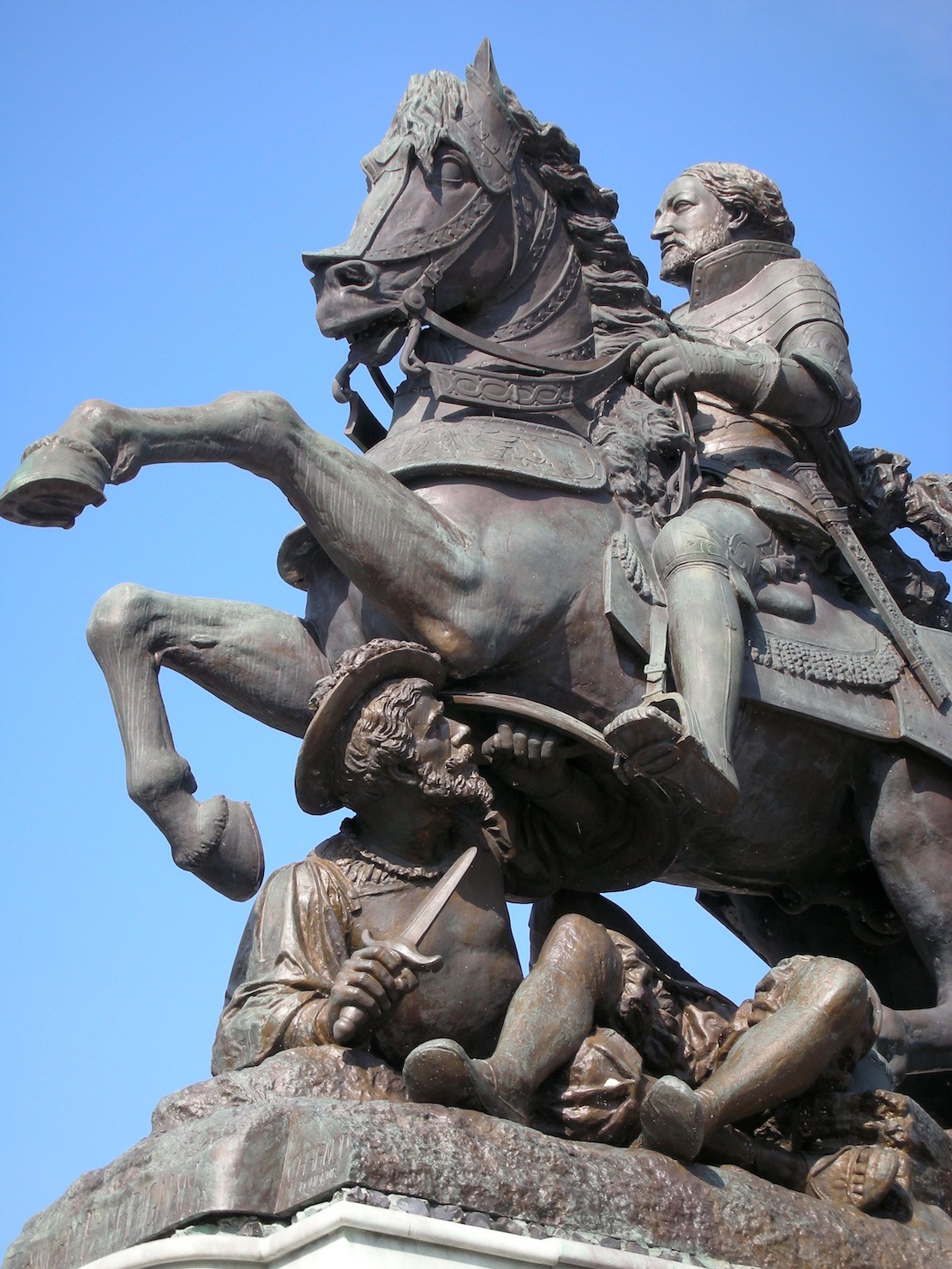 It is
easy enough to visit the town’s attractions in
one day, unless one seeks to visit several of
the finest Cognac producers in the region, like
Camus, Martell, Courvoisier, Otard, Hennessey
and many more. There is also good food to be
found in and outside of town.
It is
easy enough to visit the town’s attractions in
one day, unless one seeks to visit several of
the finest Cognac producers in the region, like
Camus, Martell, Courvoisier, Otard, Hennessey
and many more. There is also good food to be
found in and outside of town.
Cognac’s most
famous native son was Francis I (left), born
there in 1494, the son of the Count of Angoulême
and heir to the French throne only because Louis
XII died childless. By 1515 he was gone from
Cognac and living in Paris.
Parts of Cognac’s Old Town still evoke the king’s
childhood home,
with buildings from the 15th century extant
and examples of later centuries’ architecture
lining its cobbled streets. The center of town has
a quaint charm, and strolling along the Charente
River, dominated by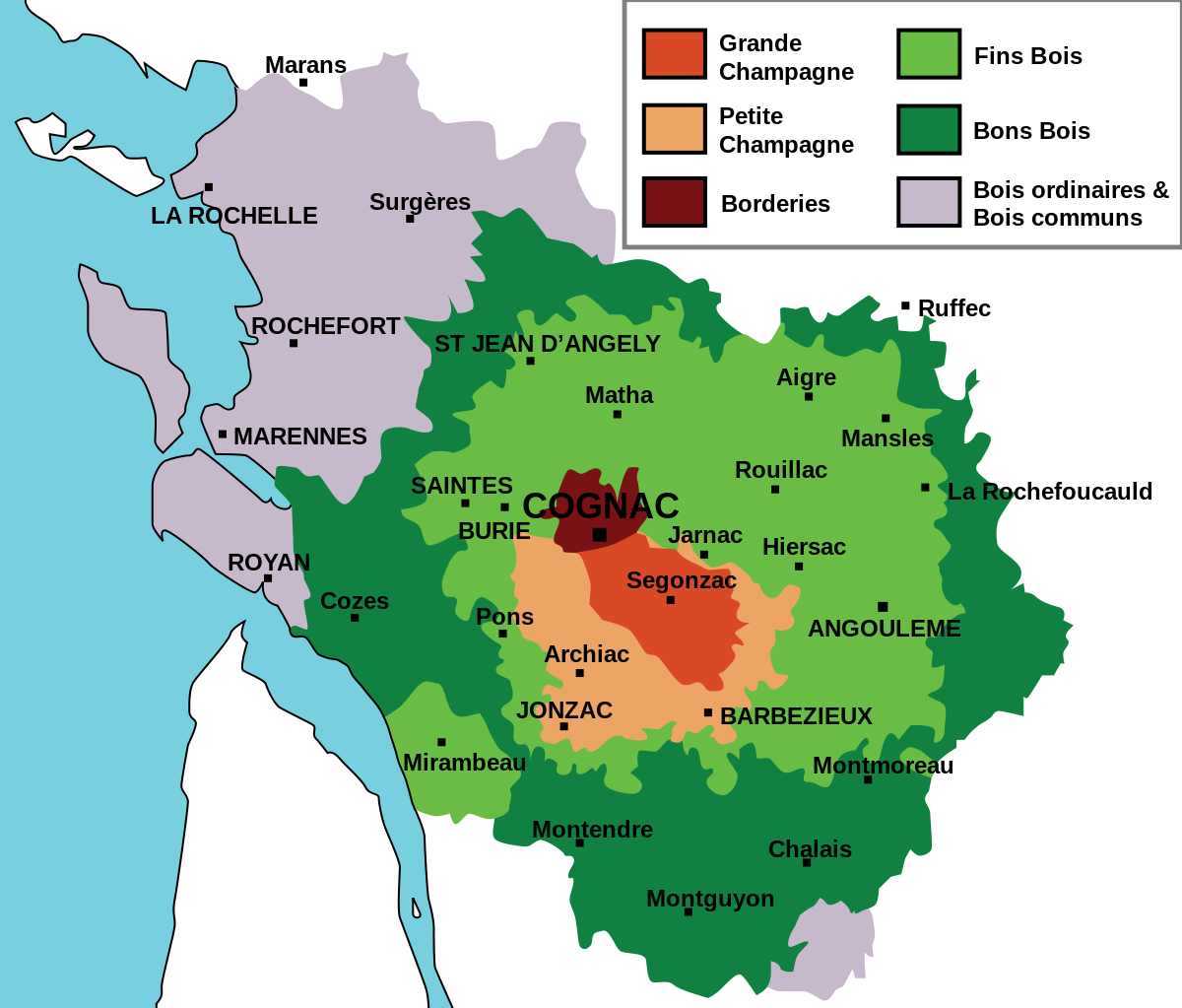 the
formidable St. Jacques Gate, is a mellow pleasure,
with the river flowing slowly by, reflecting the
Old Town’s landscape in its rippling water.
the
formidable St. Jacques Gate, is a mellow pleasure,
with the river flowing slowly by, reflecting the
Old Town’s landscape in its rippling water.
There are boat cruises with basket
lunches to book that provide fine views of the
Cognac producers’ chateaus and the surrounding
region from whose vineyards Cognac obtains its
grapes. (Some waterway tours offer two- or
three-day trips.)
Six principal vineyard areas surround the city
(there are also vineyards two hours’ drive away on
the Atlantic coast on the Île de Re), where they
grow grapes of varying character and quality from
which most producers blend different percentages
of eaux de vie to make Cognacs in their own style.
The best area is considered the Grande Champagne
(no connection to Champagne to the north), then
Petite Champagne, Borderies, Bon Bois and Bois
Ordinaire.
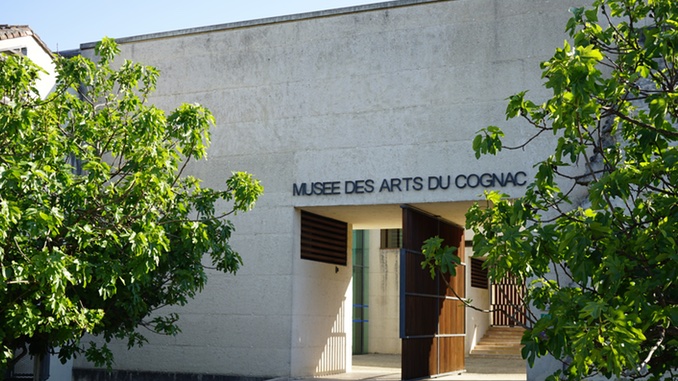 There
is a very humorous and very British scene in the
James Bond movie “Goldfinger” when 007 (Sean
Connery) gives his connoisseur’s opinion of a
“disappointing” Cognac, explaining, in his deep
Scottish burr, “It seems to be a thirty-year-old fine
indifferently blended, with an overdose of Bon
Bois.” (Fine,
pronounced “feen,” is an old term for brandy.)
There
is a very humorous and very British scene in the
James Bond movie “Goldfinger” when 007 (Sean
Connery) gives his connoisseur’s opinion of a
“disappointing” Cognac, explaining, in his deep
Scottish burr, “It seems to be a thirty-year-old fine
indifferently blended, with an overdose of Bon
Bois.” (Fine,
pronounced “feen,” is an old term for brandy.)
Right next to the river’s quai is the Musée des
Arts du Cognac, within a 16th century
mansion, whose artifacts detail both the arts and
artifacts of the city and region. Smaller but of
some interest is the Musée d’Art
et d’Histoire, whose holdings largely come
from antiques donated by the area’s wealthy
families.
The St.
Léger church (below), built in the 12th
century in the Romanesque and High Gothic styles,
though altered over many centuries, has a splendid
rose window and impressively long nave, but it is
wedged between mundane later buildings that seem
to crowd the church out on an otherwise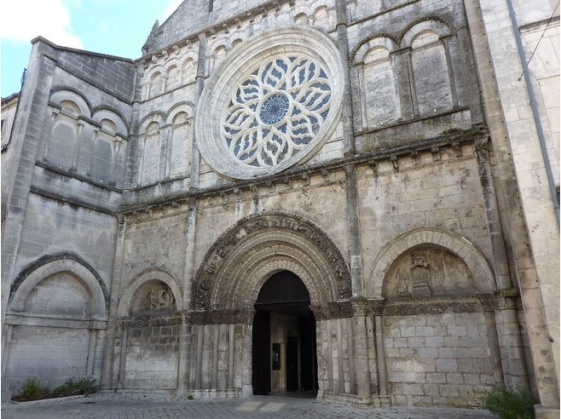 undistinguished block. Many old buildings in
Cognac are in need of repair.
undistinguished block. Many old buildings in
Cognac are in need of repair.
Up until just this year Cognac had not had a
first-class, or what the Europeans call five-star,
hotel, despite a significant spirits industry
clientele. Most places to stay are quite modest,
many in
former mansions. This summer, after the extensive
rehab of what had been a storage facility for the
Cognac trade, Hôtel Chais
Monnet Cognac opened to justified fanfare.
It’s a remarkable transformation, taking full
advantage of the huge spaces where Cognac barrels
were stored while revitalizing the beautiful
archway entrance that leads to the very modern
structures that house the hotel and two
restaurants, pool and conference space. Rooms (below) and
baths are extremely well appointed, with all
contemporary amenities and tech needs. The young
staff is eager to help with any question you might
have and can easily arrange for tours and visits
to the Cognac estates.
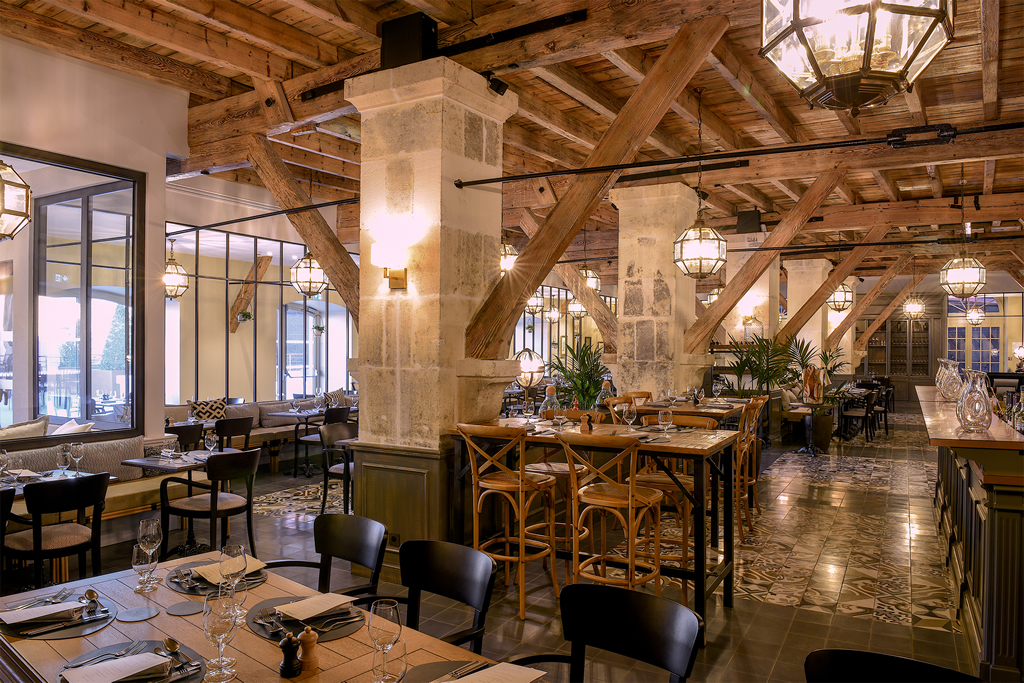 I dined at
the more casual, all-day restaurant on property, La
Distilleries (Les Foudres
is their “gourmet restaurant”), set in a spacious,
rustic room of wood ceilings and beams, solid
limestone columns and a wall of windows (left). The
menu is good “brasserie contemporaine” fare, like
a medallion of creamy foie gras with chutney and a
Cognac gelée (€25); a light dish of crab with
cucumber and mint and a dollop of yogurt (€19);
delicious red shrimp with a risotto enriched with
tomme cheese (€29); and on Saturday nights big
slabs of côte de boeuf on a mound of crisp frites.
There is a “menu tradition” of two dishes for €35,
three at €42.
(Service and tax included.)
I dined at
the more casual, all-day restaurant on property, La
Distilleries (Les Foudres
is their “gourmet restaurant”), set in a spacious,
rustic room of wood ceilings and beams, solid
limestone columns and a wall of windows (left). The
menu is good “brasserie contemporaine” fare, like
a medallion of creamy foie gras with chutney and a
Cognac gelée (€25); a light dish of crab with
cucumber and mint and a dollop of yogurt (€19);
delicious red shrimp with a risotto enriched with
tomme cheese (€29); and on Saturday nights big
slabs of côte de boeuf on a mound of crisp frites.
There is a “menu tradition” of two dishes for €35,
three at €42.
(Service and tax included.)
Widely regarded
as the best restaurant in town, the 20-year-old 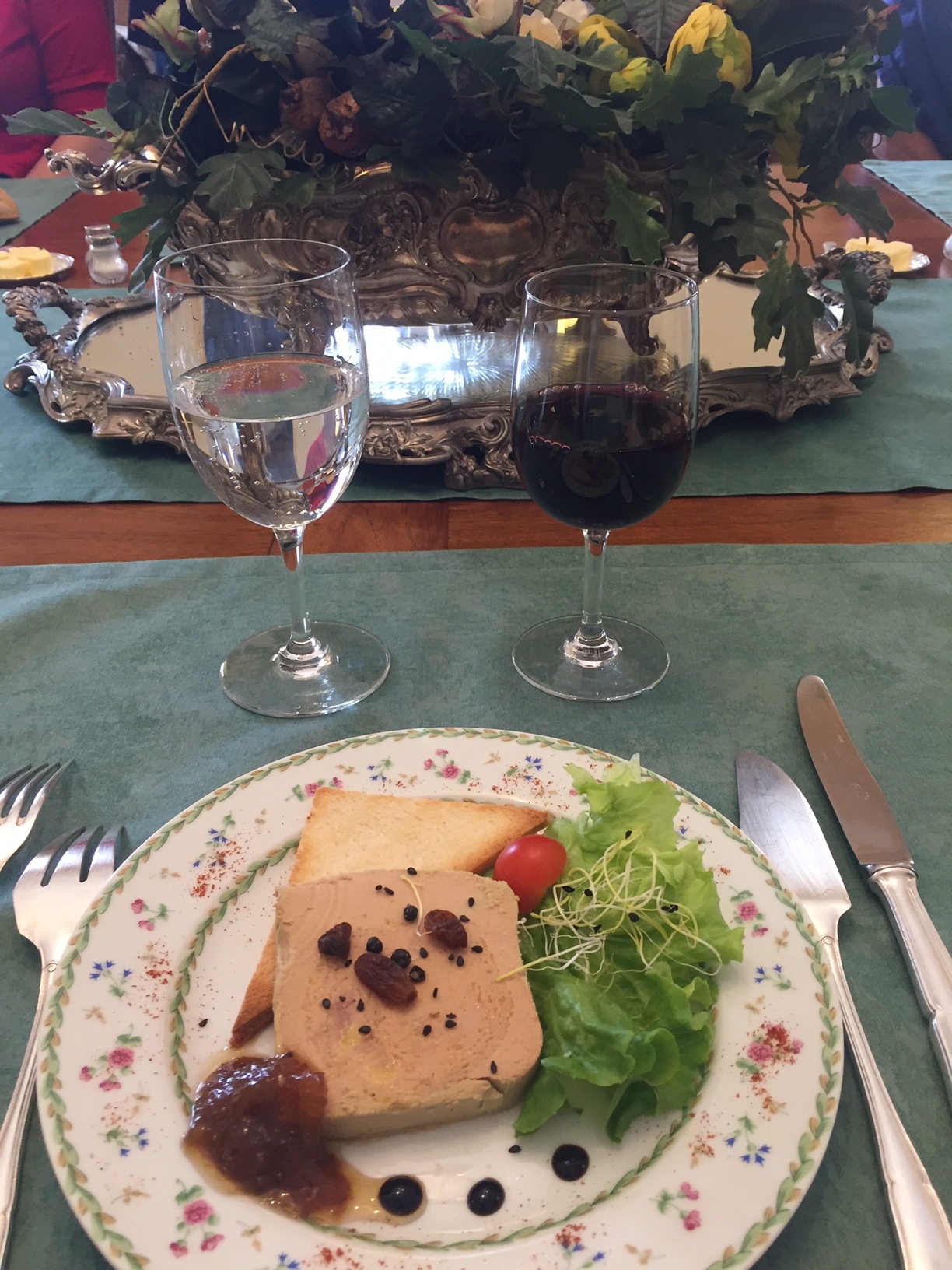 Le Bistro de
Claude, run by Claude Vezin (right), is
packed every night with locals and tourists within
a lively, highly colorful series of rooms, with
rough-hewn stone walls, antique cupboards and
modern black-and-white photos.
There are à la carte options, but the prix fixe
menu is quite a bargain at €23, €28 or €35, and
the choices the night I dined there included a cassolette of
mussels with citrus; luscious foie gras (right),
tournedos of duck splashed with a local balsamic
vinegar; and a fig tart with yuzu
cream. The wine list is excellent and rich in the
area’s Cognacs. (Service and tax included.)
Le Bistro de
Claude, run by Claude Vezin (right), is
packed every night with locals and tourists within
a lively, highly colorful series of rooms, with
rough-hewn stone walls, antique cupboards and
modern black-and-white photos.
There are à la carte options, but the prix fixe
menu is quite a bargain at €23, €28 or €35, and
the choices the night I dined there included a cassolette of
mussels with citrus; luscious foie gras (right),
tournedos of duck splashed with a local balsamic
vinegar; and a fig tart with yuzu
cream. The wine list is excellent and rich in the
area’s Cognacs. (Service and tax included.)
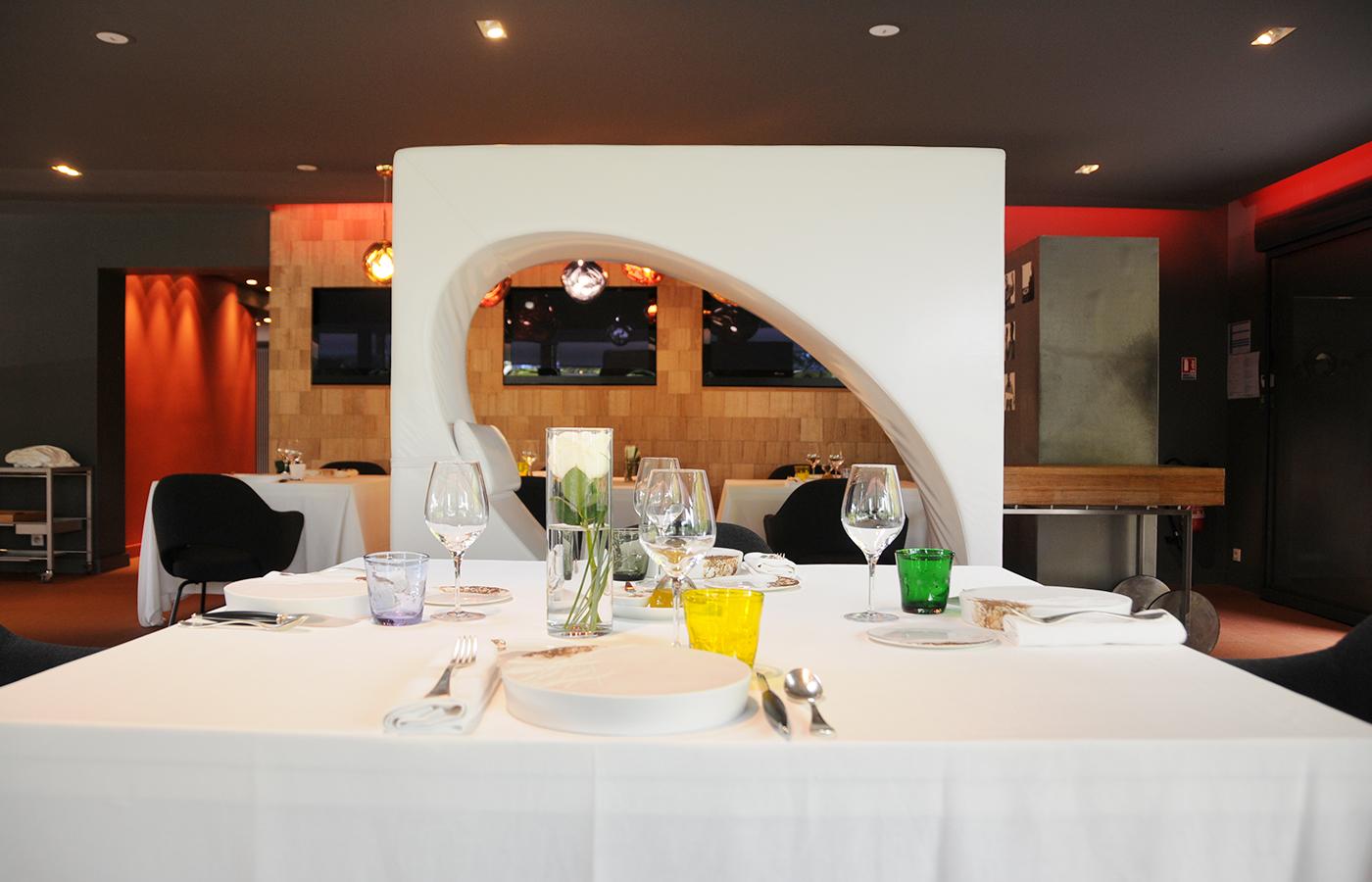 Outside of
town by about 20 minutes is the area’s only
Michelin star restaurant, La
Ribaudière (left) in Jarnac, run by
chef Thierry Verrat. Flanking a quiet garden on
the Charente River is a terrace where you can have
cocktails or Champagne with amuses like
mackerel on a potato wafer with caviar and quinoa.
Inside, the restaurant is thoroughly modern, done
in bright, vivid colors of red and violet, with
wide, well-decorated tables (though the
wineglasses
Outside of
town by about 20 minutes is the area’s only
Michelin star restaurant, La
Ribaudière (left) in Jarnac, run by
chef Thierry Verrat. Flanking a quiet garden on
the Charente River is a terrace where you can have
cocktails or Champagne with amuses like
mackerel on a potato wafer with caviar and quinoa.
Inside, the restaurant is thoroughly modern, done
in bright, vivid colors of red and violet, with
wide, well-decorated tables (though the
wineglasses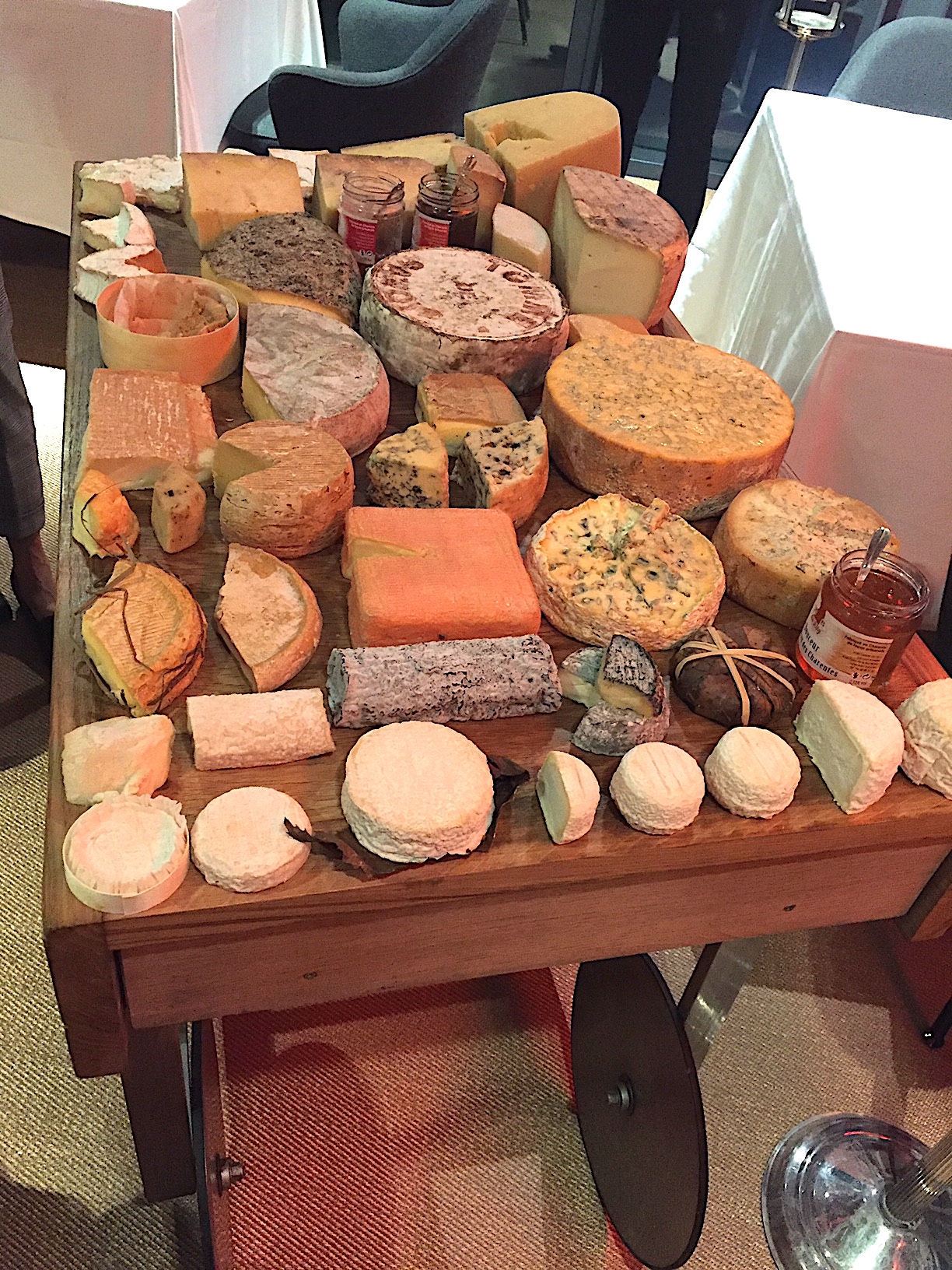 are, surprisingly, not
all of high quality).
are, surprisingly, not
all of high quality).
The cuisine, which is pricey, can be overly fussy
on the plate, but the quality of ingredients and
preparation are superb, from mi-cuit
foie gras with smoked eel nubbins (€42) to very
tender snails on a crisp salad and carrot strips
(€37). Local sturgeon caviar from Gensac-La-Pallue
tops raw lobster with a fish gelée (€55).
Among the main courses was an extraordinary
soufflé of pike with rice flavored with shellfish
and more caviar (€37). Filet of Saint-Pierre came
with a concasse
of oysters and beet risotto (€42), and tournedos
of flavorful baby lamb were accompanied by
asparagus of the season and morel juice (€43).
Most appealing was a cart of what must have been
30 cheeses in peak condition, well described and
served with admirable dispatch.
Desserts encompass a
refreshing salad of raspberries with honey, olive
oil and meringues and a nut tart with
praline-caramel-citrus (both €17). There are also
bargain prix fixe menus at €50, €62, €72, €106 and
€112. (Service and tax included.)
❖❖❖
By John Mariani
355 West 16th Street (near Ninth Avenue)
212-885-9400
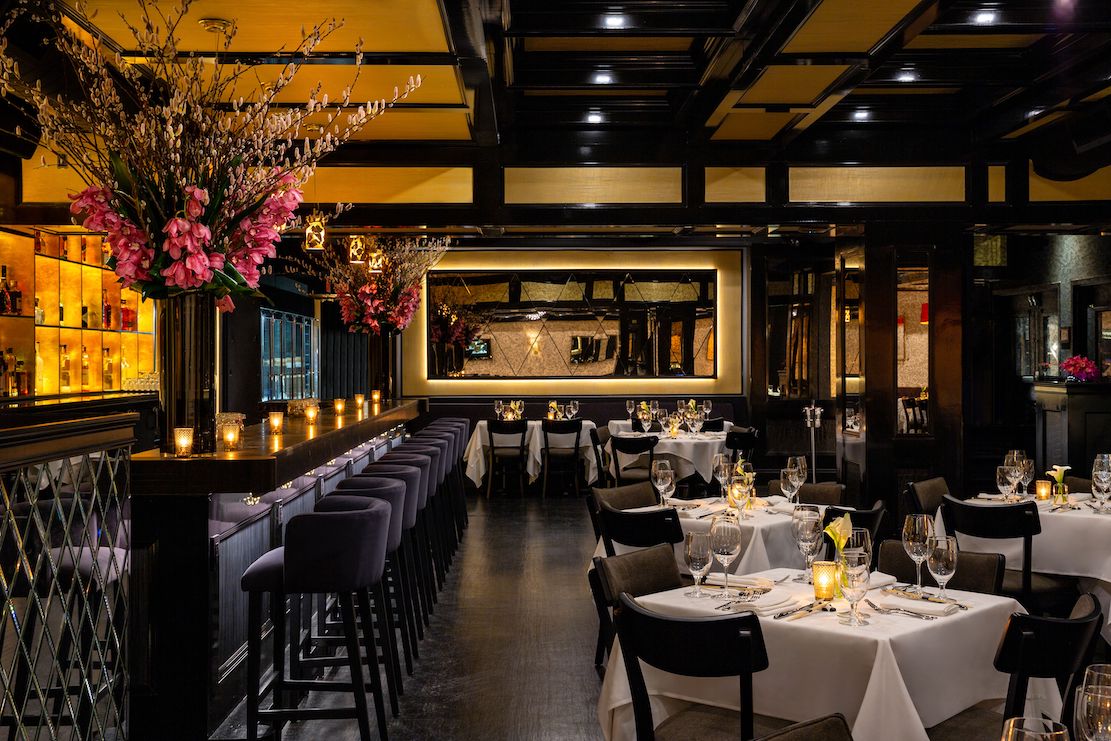
The fact that, since January,
Philippe Chow in the Meatpacking District has
emerged as one of the most glamorous-looking
restaurants of any stripe in New York won’t come
as a total surprise as you descend a dark,
mirrored staircase to the dining room. Its
predecessor, Megu, though far different in
design—all red and neon—was built both to
attract and to wow a glam crowd. Philippe Chow
has a cooler vibe of sleek black and taupe, with
glowing lights and a stunning back-lit bar. Even
on a recent slow summer Tuesday night, 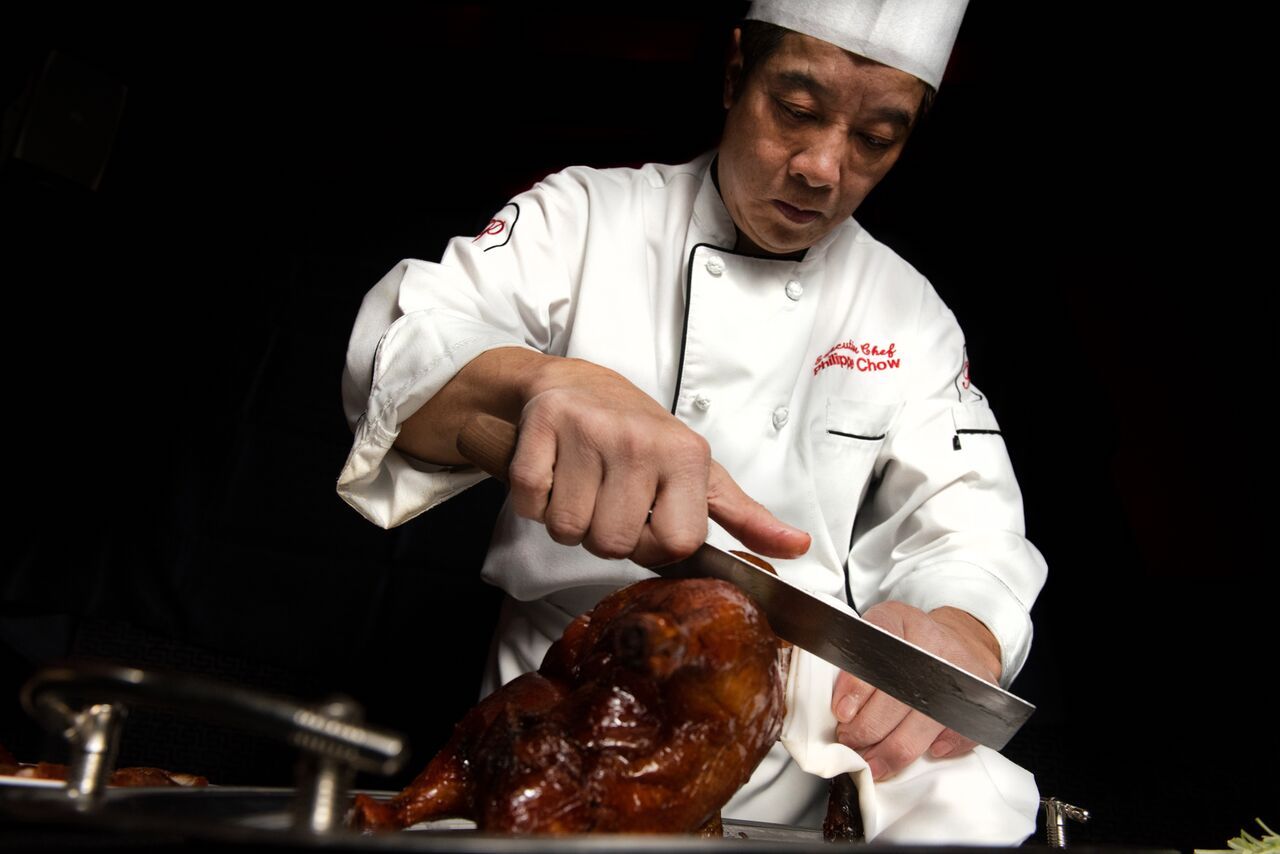 the women guests
dressed to the nines in spaghetti strap tops,
tight mini skirts and spiked heels; the men
favored very tight black t-shirts and shaved
heads. Tattoos were in flagrant display.
the women guests
dressed to the nines in spaghetti strap tops,
tight mini skirts and spiked heels; the men
favored very tight black t-shirts and shaved
heads. Tattoos were in flagrant display.
This is chef-owner Philippe Chow’s second
restaurant. His first has been on the Upper East
Side for fourteen years and still appeals to
patrons who know that it has no connection to the
restaurants called Mr. Chow. The name confusion
caused quite a stir when Mr. Chow’s owner, Michael
Chow, sued Philippe Chow (left) for being a deliberate
knock-off of the older restaurant, which has
branches in New York, London and Beverly Hills. To
make a long story short, Philippe Chow showed that
his last name would take up several pages in a
Hong Kong phone book, and that was that.
Philippe Chow’s restaurant also differs from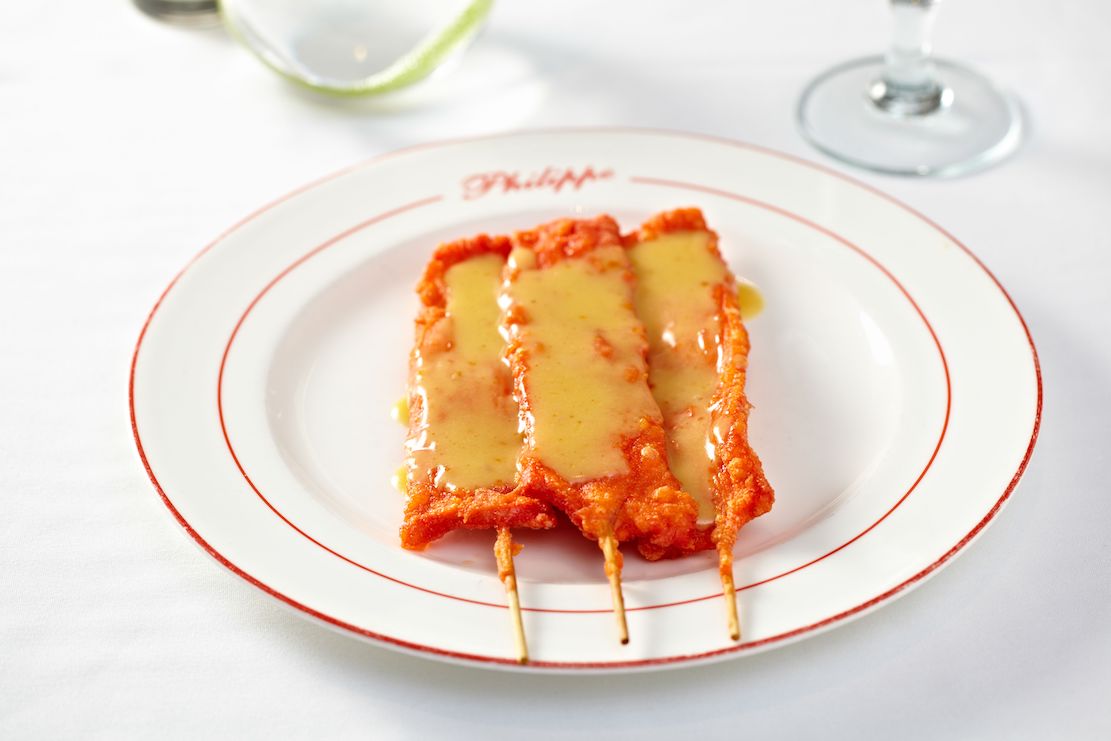 Mr. Chow by having much
better food and from a huge Asian nightclub like
Tao by actually focusing on the food and not the
razzle-dazzle. He is always at one of his
restaurants, often at both in a night, and his
menu is long with traditional favorites and his
own new dishes, like the curried calamari ($24) he
recommended to us.
He also has a full-time pastry chef.
Mr. Chow by having much
better food and from a huge Asian nightclub like
Tao by actually focusing on the food and not the
razzle-dazzle. He is always at one of his
restaurants, often at both in a night, and his
menu is long with traditional favorites and his
own new dishes, like the curried calamari ($24) he
recommended to us.
He also has a full-time pastry chef.
A good beginning is one of the smoky satay
dishes on skewers, like chicken (right) with
peanut-sesame sauce ($3 each), or the lettuce
wraps which you fill with seasoned minced meat or
vegetables, fold up and eat with your fingers
($18). “Mr. Cheng’s Noodles” are hand pulled and
retain that wonderful elasticity when combined
with a classic pork sauce, and I could eat platter
after platter of Chow’s dumplings, especially the
pork soup variety, whose liquid gushes out of the
delicate dough and fills your mouth with flavor
($6 each). Green prawns are stir-fried with
vegetables, a good shot of garlic and toasty
cashews ($37), and a rosy filet mignon is crusted
by a good searing then sauced with an assertive
black pepper crunch ($41).
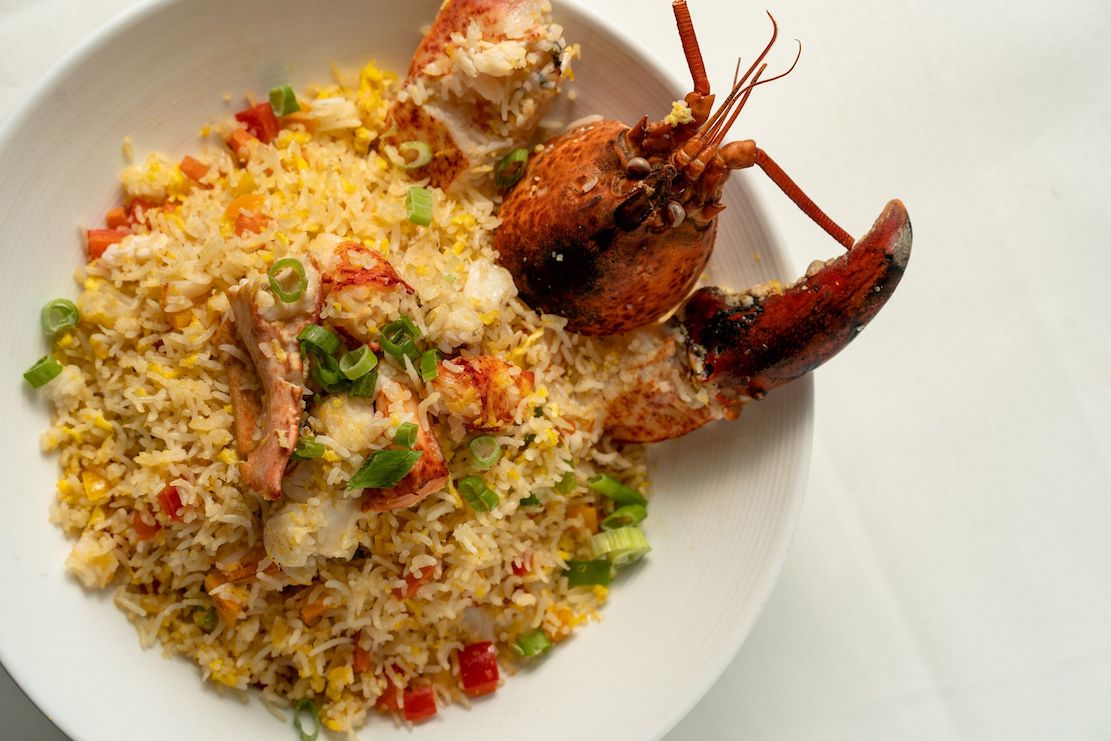 Peking
duck is always the measure of a Chinese
restaurant, and Chow’s is a fine one (you can have
it for two or more people, up to $85), with very
thin, crisp mahogany skin, the proper amount of
fat and velvety flesh to be wrapped with scallions
in a delicate pancake. I wish the hoisin sauce had
not been so thick, and it would have been even
nicer if they had preceded the meat with a duck
soup.
Peking
duck is always the measure of a Chinese
restaurant, and Chow’s is a fine one (you can have
it for two or more people, up to $85), with very
thin, crisp mahogany skin, the proper amount of
fat and velvety flesh to be wrapped with scallions
in a delicate pancake. I wish the hoisin sauce had
not been so thick, and it would have been even
nicer if they had preceded the meat with a duck
soup.
To go with main courses, have the moist, fragrant
vegetable fried rice ($12).
I don’t expect Chinese restaurants to have
first-rate desserts, but Philippe Chow’s warm
flourless dark chocolate cake with caramel,
frosted cocoa nibs and vanilla ice cream; warm
apple and almond tart with caramel, almond
crumble and soy milk ice cream; and the creamy
coconut mousse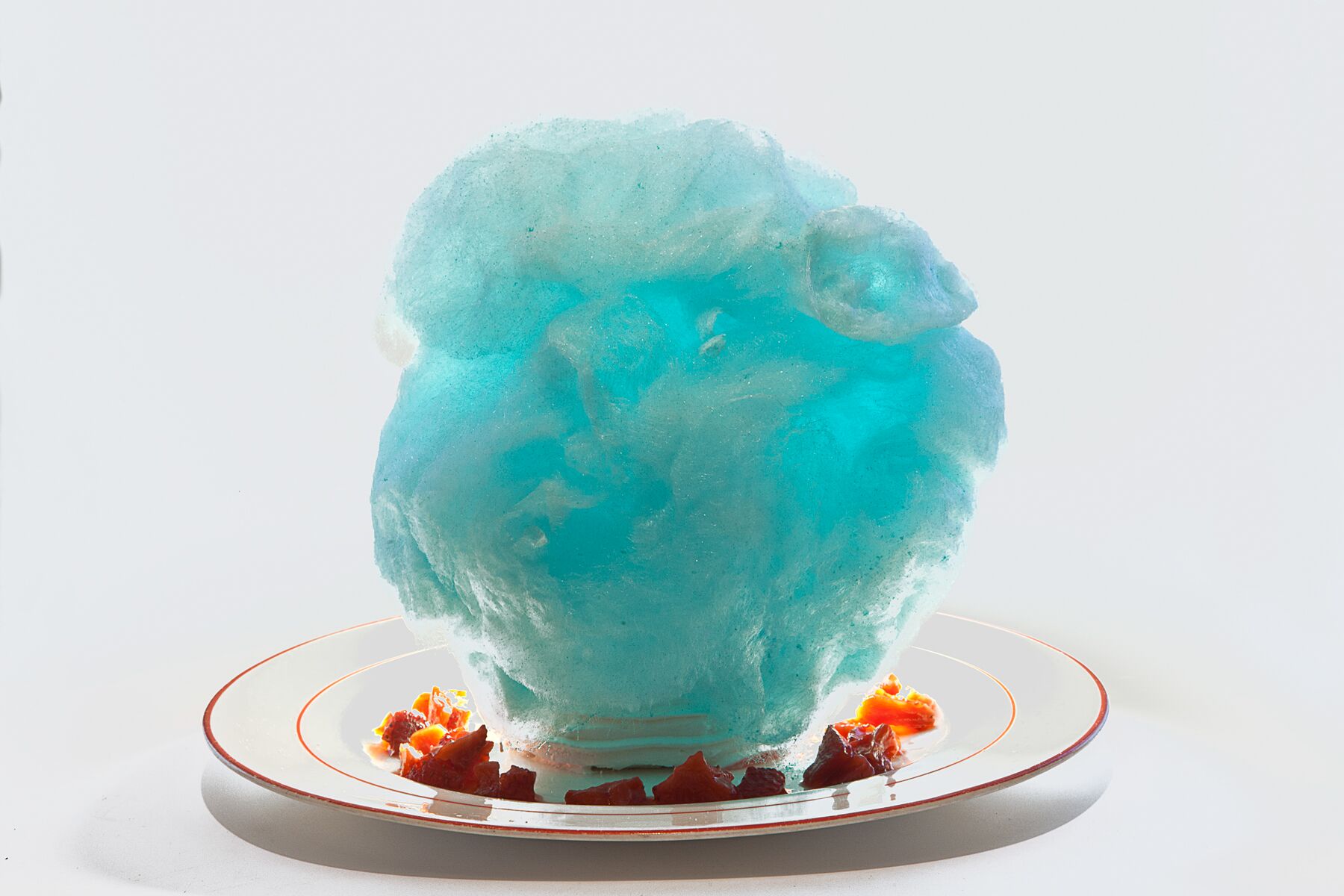 (all
$14) would be a hit at any American restaurant
in town. Unique, however, is the cotton candy
baked Alaska (below),
which arrives like a carnival confection of
cotton candy, which, when you insert a fork,
collapses over meringue, strawberry
semifreddo, chocolate cake and roasted
strawberries ($18). It’s a showpiece, certainly,
but it also irresistible.
(all
$14) would be a hit at any American restaurant
in town. Unique, however, is the cotton candy
baked Alaska (below),
which arrives like a carnival confection of
cotton candy, which, when you insert a fork,
collapses over meringue, strawberry
semifreddo, chocolate cake and roasted
strawberries ($18). It’s a showpiece, certainly,
but it also irresistible.
Philippe Chow
has a considerable wine list, and there are good
bottles at reasonable prices. The wines by the
glass, which is a good way to go in a Chinese
restaurant with so many disparate sweet and salty
flavors, are a very good selection—if
pricey—ranging from Livio Felluga Pinot Grigio
2016 ($19) to a Chapoutier Côtes-du-Rhône 2017
($15). As
you might expect, there is a long list of
specialty cocktails ($17 to $22).
So there’s a lot going on at
Philippe Chow, starting with that descent down
that mirrored staircase into a shadowy, sexy
space where the menu is full of both traditional
Chinese pleasures and novel ideas. It’s all in
good fun but it’s also all buoyed by very good
taste.
❖❖❖
By John Mariani
FUTURE IN DIVERSITY
La Gîte, home of the Camus family
Long regarded as the highest expression of distilled grapes into brandy, Cognac has been enjoying soaring sales along with other “brown goods” like Scotch, bourbon and rye. According to the Bureau National Interprofessionnel du Cognac, Cognac shipments were up 10.3% in 2018, with 200.8 million bottles shipped, valued at €3.162 billion. By far the highest exports were to North America—88.4 million bottles—with Asia, Europe and the rest of the world following.
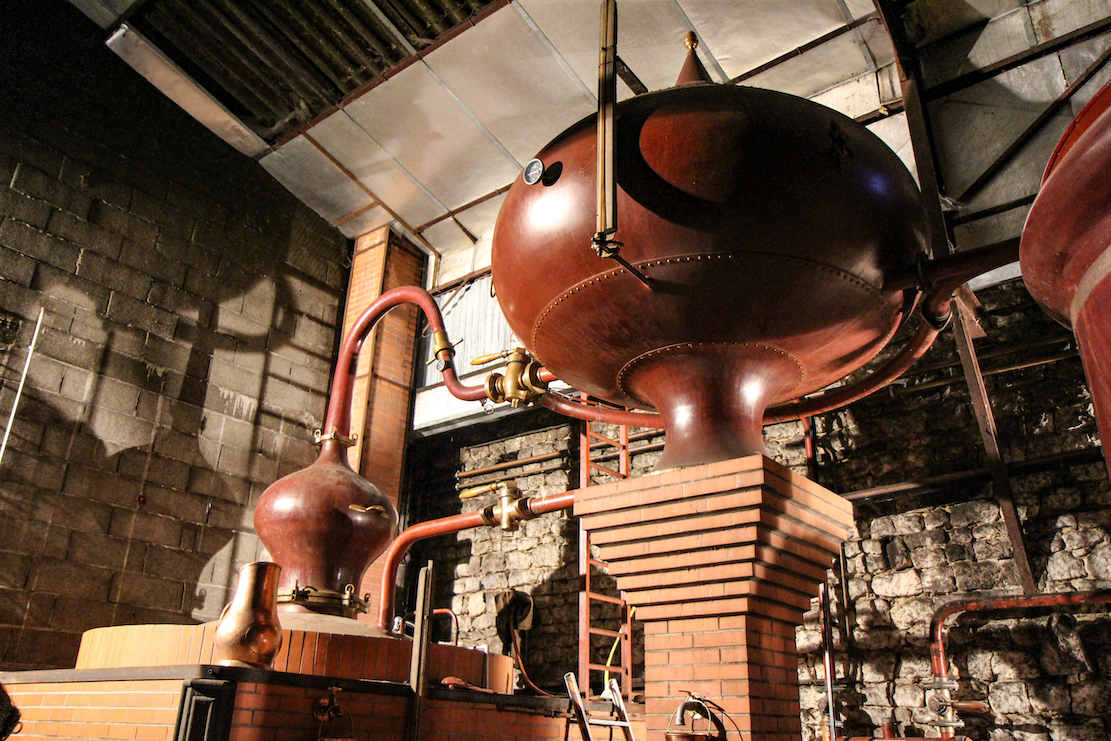 The gorilla
in the room is LMVH’s Hennessey, with nearly half
the total sales of Cognac, followed by Pernod
Ricard’s Martell, Rémy Cointreau’s Rémy Martin and
Beam Suntory’s Courvoisier. In
fifth place is Camus, which has been family owned
since 1863—the last in the industry—for five
generations, and currently headed by 48-year-old
President Cyril Camus, who is trying to
distinguish his brand from the rest through
innovations like its signature Borderies XO as
well as Cognacs tailored to specifications on the
French island of Île de Ré.
The gorilla
in the room is LMVH’s Hennessey, with nearly half
the total sales of Cognac, followed by Pernod
Ricard’s Martell, Rémy Cointreau’s Rémy Martin and
Beam Suntory’s Courvoisier. In
fifth place is Camus, which has been family owned
since 1863—the last in the industry—for five
generations, and currently headed by 48-year-old
President Cyril Camus, who is trying to
distinguish his brand from the rest through
innovations like its signature Borderies XO as
well as Cognacs tailored to specifications on the
French island of Île de Ré.
Camus now sells 3 million bottles per year in 140 countries, last year turning over €120 million, with 97% of sales from exports. Important to that aspect of the business is Camus’s presence in more than 300 international airport duty free shops.
Under Vice President-Eaux-de-Vie & Cellar Master Patrick Léger (below), an array of new Cognacs have been offered in recent years whose overall character, he says, is “intensity,” which is achieved in various ways, including “finishes” in different kinds of oak barrels. (All Cognac is distilled from Ugni Blanc grapes, sometimes with quantities of Folle Blanche and Colombard.)
In September I visited
Camus, and while I did not meet Cyril Camus,
I did have interviews with Patrick Léger, a former
French special forces officer and now Chief
Marketing  Officer
Jean-Dominique Andreu and Master Blender Fréderic
Dézauzier, who showed me the distilleries, with
their huge copper pot stills (above) and
vast barrel rooms. I was also brought to their
very modern Camus Visitor Center (21 Rue de Cagouillet),
open, by appointment, to the public for tours to
"discover the world" of Cognac and Camus history
and a unique, two-hour “Master Blender” workshop (below). Here,
under guidance, you create your own 50cl bottle of
XO Cognac.
Officer
Jean-Dominique Andreu and Master Blender Fréderic
Dézauzier, who showed me the distilleries, with
their huge copper pot stills (above) and
vast barrel rooms. I was also brought to their
very modern Camus Visitor Center (21 Rue de Cagouillet),
open, by appointment, to the public for tours to
"discover the world" of Cognac and Camus history
and a unique, two-hour “Master Blender” workshop (below). Here,
under guidance, you create your own 50cl bottle of
XO Cognac.
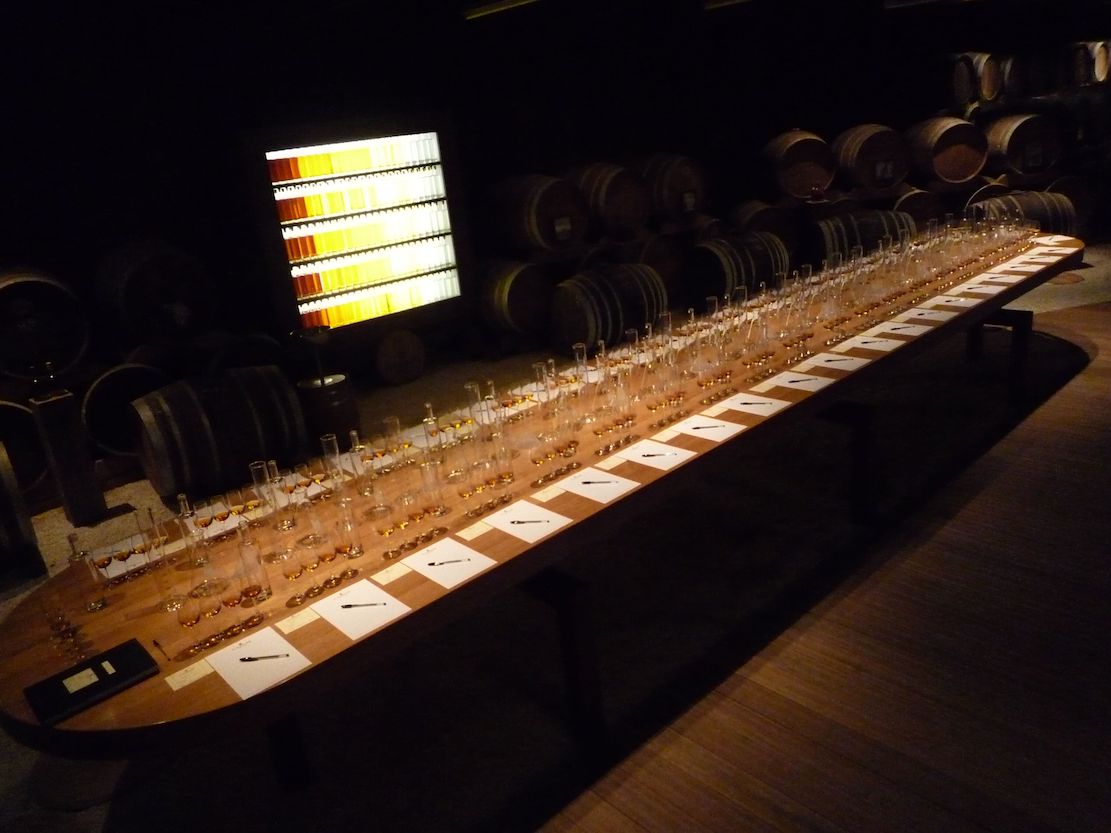 I was able to taste
many of Camus’s current portfolio of Cognacs and
recognized what the company is aiming to achieve
through so many “expressions” of the spirit.
I was able to taste
many of Camus’s current portfolio of Cognacs and
recognized what the company is aiming to achieve
through so many “expressions” of the spirit.
The Borderies region comprises only 5% of the Cognac Appellation vineyards, but Camus is the largest owner of land in the Borderies, with 188 hectares (465 acres) of vineyards. Camus has gone against the grain by always assembling some eaux-de-vie from the Borderies district in their Cognac blends from other crus, which are Grande Champagne (no connection to Champagne to the north), then Petite Champagne, Fin Bois, Bon Bois and Bois à Terroirs.
Borderies spirits are particularly aromatic, and upon tasting Camus’s VSOP I found it indeed full of peach and apricot aromas, soft and round, with a long finish on the back of the palate. Even more so was their XO Family Reserve single estate.
Camus has been in
the forefront in Cognac in offering spirits with
different finishes, as has become popular with
bourbon, Scotch
and Irish 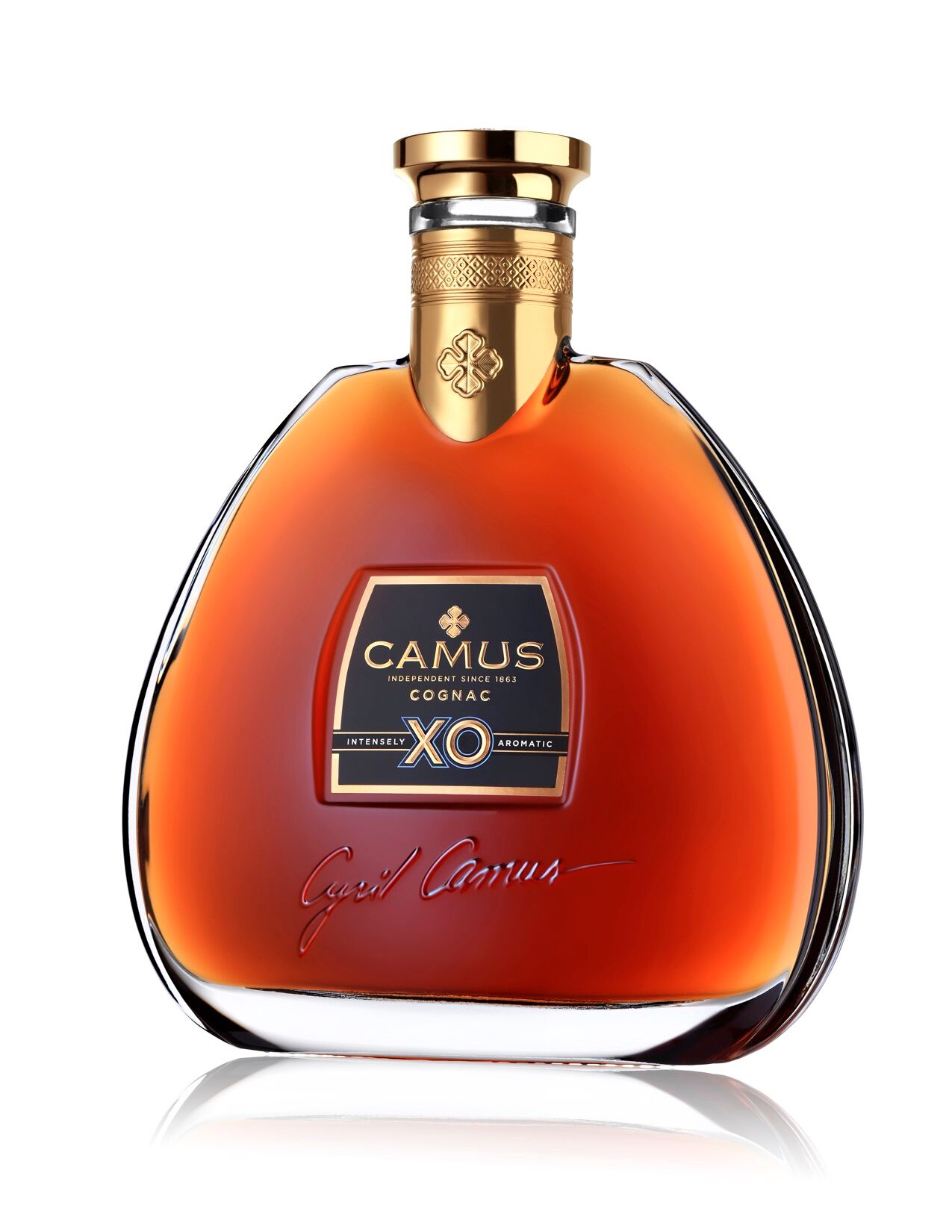 Whiskey in recent years. The St. Aulaye
Monbazillac Cask Finish is Cognac aged in casks
from the sweet wine casks Dordogne region of
France, which imparts a sweetness at the end of
the palate, while the Port Cask Finish is aged
traditionally before being finished in Tawny Port
barrels, resulting in 43.2% alcohol and rich
aromas familiar to Port lovers. Caribbean
Expedition is unique—a small batch of Cognac
actually matured in Oceanic and Tropical climates,
which certainly pushes the envelope in the highly
traditional Cognac industry.
Whiskey in recent years. The St. Aulaye
Monbazillac Cask Finish is Cognac aged in casks
from the sweet wine casks Dordogne region of
France, which imparts a sweetness at the end of
the palate, while the Port Cask Finish is aged
traditionally before being finished in Tawny Port
barrels, resulting in 43.2% alcohol and rich
aromas familiar to Port lovers. Caribbean
Expedition is unique—a small batch of Cognac
actually matured in Oceanic and Tropical climates,
which certainly pushes the envelope in the highly
traditional Cognac industry.
Camus is no stranger to smart modern packaging
either, especially after the success of Rémy
Martin’s Louis XIII Cognac sold in a Baccarat
crystal bottle.
Today Camus has
revived for certain markets La Grande Marque
Cognac, whose gold crown atop the bottle
references its favor among the Kings of Sweden and
Cambodia. Another, Extra 48.8, which looks like a
couture perfume bottle, is called the “Angel’s
Share,” evoking the idea that the alcohol that
emerges naturally from the barrels rises to heaven
to be enjoyed by angels.
Camus does use blends for other iterations, like its glamorously boxed Extra Elegance using eaux de vie from the Borderies, Grande Champagne and Petite Champagne regions. (There is even a package made specifically for the duty free market only.) From the Extra Cognacs, Cyril Camus asked Léger to create Extra Dark & Intense from the best barrels, then the eaux-de-vie undergo an unusual process of emptying the barrels, which are then slightly heated to “release the Cognac trapped inside the very grain of the oak staves.” The eaux-de-vie are then returned to those barrels for finishing.
I was also fortunate to
visit Île de Re, a long, flat lobster-shaped
island off the coast of France where in 2004 Camus
began making Cognacs to take advantage of the
salty, iodine-rich minerals soils. On the grounds
of the 17th century Fort de la Prée (left), where
for centuries the very rough waters kept English
and other invaders at bay, I was shown an old
stone structure that could have served as a guard
house or jail straight out of Treasure
Island.
A wonderfully creaky door opens onto a
dark, dank interior festooned with cobwebs and
coated with mold (below). Here, in this
hot-in-summer-cold-in-winter, damp atmosphere, Camus
first matures its Île de Re Cognac in that damp
cellar then brings it back to the town of Cognac
and pours it into very old barrels that impart a distinctive
smokiness to the spirit.
I saw but did not sample some very special, very expensive limited bottlings, some with vintage dates, that are sold for special markets, like its Jean-Paul Camus 1945 Private Réserve and Rarissimes 1940 Vintage in a Baccarat crystal bottle.
After being exposed to so many different Cognacs, I asked Jean-Dominique and Fréderic if such an array might serve to confuse the public, the way novel interpretations of Port and whiskies may bewilder potential buyers with too many choices. Cognac lovers stay true to one label, knowing master blenders work hard to always deliver the exact flavors and aromas of the house style. Would they start experimenting with all these new products from one producer?
Their answer was quite simple and based on the way the world now spins: Those who love a traditional bottling will always do so, but with the expansion of Cognac into so many global markets, there are brand new audiences for Cognac. Since 2007 Camus has been sold in China by its Yuanliu subsidiary, while its current Russian distributor, Beluga Group, has experienced double-digit growth in Russia.
Because these new markets, which include the current generation of Millennials in the U.S., are not bound to one Cognac brand, Camus believes by offering an array in various price ranges and gift packaging, it will build a corps of new Cognac lovers whose willingness to try different styles will make for more nuanced choices and a more refined clientele.
 PERHAPS TIME TO SEEK
HELP
PERHAPS TIME TO SEEK
HELP
"Some
people collect stamps, or Depression Glass, or
vintage community cookbooks. I collect enchiladas,
an obsessive pastime I have pursued since I first
learned to love this comfort food of all comfort
foods as a brand-new Texan back in the mid-1960s.”-- Alison Cook, "New
additions to my Houston Enchilada Hall of Fame," Houston
Chronicle
(7/16)
GOD FORBID YOU
SHOULD SIT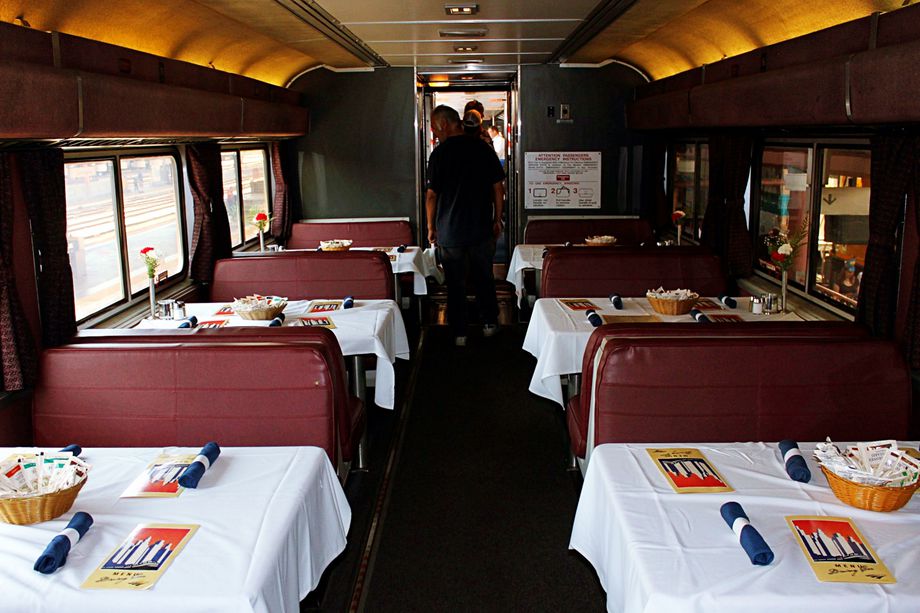
NEXT TO SOMEONE ON A TRAIN!
Any of John Mariani's books below may be ordered from amazon.com.
 The Hound in Heaven
(21st Century Lion Books) is a novella, and
for anyone who loves dogs, Christmas, romance,
inspiration, even the supernatural, I hope you'll find
this to be a treasured favorite. The story
concerns how, after a New England teacher, his wife and
their two daughters adopt a stray puppy found in their
barn in northern Maine, their lives seem full of promise.
But when tragedy strikes, their wonderful dog Lazarus and
the spirit of Christmas are the only things that may bring
his master back from the edge of despair.
The Hound in Heaven
(21st Century Lion Books) is a novella, and
for anyone who loves dogs, Christmas, romance,
inspiration, even the supernatural, I hope you'll find
this to be a treasured favorite. The story
concerns how, after a New England teacher, his wife and
their two daughters adopt a stray puppy found in their
barn in northern Maine, their lives seem full of promise.
But when tragedy strikes, their wonderful dog Lazarus and
the spirit of Christmas are the only things that may bring
his master back from the edge of despair. WATCH THE VIDEO!
“What a huge surprise turn this story took! I was completely stunned! I truly enjoyed this book and its message.” – Actress Ali MacGraw
“He had me at Page One. The amount of heart, human insight, soul searching, and deft literary strength that John Mariani pours into this airtight novella is vertigo-inducing. Perhaps ‘wow’ would be the best comment.” – James Dalessandro, author of Bohemian Heart and 1906.
“John Mariani’s Hound in Heaven starts with a well-painted portrayal of an American family, along with the requisite dog. A surprise event flips the action of the novel and captures us for a voyage leading to a hopeful and heart-warming message. A page turning, one sitting read, it’s the perfect antidote for the winter and promotion of holiday celebration.” – Ann Pearlman, author of The Christmas Cookie Club and A Gift for my Sister.
“John Mariani’s concise, achingly beautiful novella pulls a literary rabbit out of a hat – a mash-up of the cosmic and the intimate, the tragic and the heart-warming – a Christmas tale for all ages, and all faiths. Read it to your children, read it to yourself… but read it. Early and often. Highly recommended.” – Jay Bonansinga, New York Times bestselling author of Pinkerton’s War, The Sinking of The Eastland, and The Walking Dead: The Road To Woodbury.
“Amazing things happen when you open your heart to an animal. The Hound in Heaven delivers a powerful story of healing that is forged in the spiritual relationship between a man and his best friend. The book brings a message of hope that can enrich our images of family, love, and loss.” – Dr. Barbara Royal, author of The Royal Treatment.
 |
The Encyclopedia of American Food and Drink by John F. Mariani (Bloomsbury USA, $35) Modesty forbids me to praise my own new book, but let me proudly say that it is an extensive revision of the 4th edition that appeared more than a decade ago, before locavores, molecular cuisine, modernist cuisine, the Food Network and so much more, now included. Word origins have been completely updated, as have per capita consumption and production stats. Most important, for the first time since publication in the 1980s, the book includes more than 100 biographies of Americans who have changed the way we cook, eat and drink -- from Fannie Farmer and Julia Child to Robert Mondavi and Thomas Keller. "This book is amazing! It has entries for everything from `abalone' to `zwieback,' plus more than 500 recipes for classic American dishes and drinks."--Devra First, The Boston Globe. "Much needed in any kitchen library."--Bon Appetit. |
"Eating Italian will never be the same after reading John Mariani's entertaining and savory gastronomical history of the cuisine of Italy and how it won over appetites worldwide. . . . This book is such a tasteful narrative that it will literally make you hungry for Italian food and arouse your appetite for gastronomical history."--Don Oldenburg, USA Today. "Italian
restaurants--some good, some glitzy--far
outnumber their French rivals. Many of
these establishments are zestfully described
in How Italian Food Conquered the World, an
entertaining and fact-filled chronicle by
food-and-wine correspondent John F.
Mariani."--Aram Bakshian Jr., Wall Street
Journal.
"Equal parts
history, sociology, gastronomy, and just
plain fun, How Italian Food Conquered the
World tells the captivating and delicious
story of the (let's face it) everybody's
favorite cuisine with clarity, verve and
more than one surprise."--Colman Andrews,
editorial director of The Daily
Meal.com. "A fantastic and fascinating
read, covering everything from the influence
of Venice's spice trade to the impact of
Italian immigrants in America and the
evolution of alta cucina. This book will
serve as a terrific resource to anyone
interested in the real story of Italian
food."--Mary Ann Esposito, host of PBS-TV's
Ciao
Italia. "John Mariani has written the
definitive history of how Italians won their
way into our hearts, minds, and
stomachs. It's a story of pleasure over
pomp and taste over technique."--Danny Meyer,
owner of NYC restaurants Union Square
Cafe, The Modern, and Maialino.
|
 |
 |
 |
 |
 |
 |
 |
 |
 Everett Potter's Travel Report:
Everett Potter's Travel Report: 
 Eating Las Vegas
JOHN CURTAS has been covering the Las Vegas
food and restaurant scene since 1995. He is
the co-author of EATING LAS VEGAS – The 50
Essential Restaurants (as well as
the author of the Eating Las Vegas web site: www.eatinglasvegas.
He can also be seen every Friday morning as
the “resident foodie” for Wake Up With the
Wagners on KSNV TV (NBC) Channel 3 in
Las Vegas.
Eating Las Vegas
JOHN CURTAS has been covering the Las Vegas
food and restaurant scene since 1995. He is
the co-author of EATING LAS VEGAS – The 50
Essential Restaurants (as well as
the author of the Eating Las Vegas web site: www.eatinglasvegas.
He can also be seen every Friday morning as
the “resident foodie” for Wake Up With the
Wagners on KSNV TV (NBC) Channel 3 in
Las Vegas.
MARIANI'S VIRTUAL GOURMET
NEWSLETTER is published weekly. Publisher: John Mariani. Editor: Walter Bagley. Contributing Writers: Christopher Mariani,
Robert Mariani, Misha Mariani, John A. Curtas, Gerry Dawes, Geoff Kalish,
and Brian Freedman. Contributing
Photographer: Galina Dargery. Technical
Advisor: Gerry
McLoughlin.
If you wish to subscribe to this
newsletter, please click here: http://www.johnmariani.com/subscribe/index.html
© copyright John Mariani 2019

